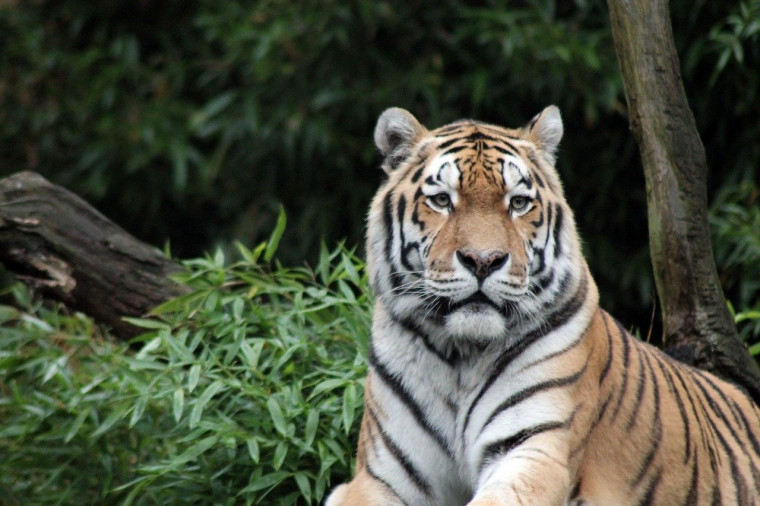Advocate for Tigers: Their Survival is in Our Hands
Tigers have captured the imagination and earned the respect of humankind for thousands of years. Yet these big cats are disappearing at an alarming rate. On International Tiger Day, the Center for Animal Law Studies offers insight into current threats and how we can all help protect these magnificent creatures.
Open gallery

It’s the 11th anniversary of International Tiger Day and this year’s theme is “Their Survival is in Our Hands”. While efforts to protect tigers have increased since the launch of the event, tigers still face significant threats. Below, we provide a brief overview of some of the key threats facing tigers and, for each, provide ways that you can help and become an advocate for tiger protection.
Tigers Belong in the Wild, Not Our Backyards. While tigers are awe-inspiring, they deserve to live free—not in basements, backyards, or bathrooms where many of the tigers in the U.S. reside. An estimated 5,000-15,000 tigers live in captivity in the U.S., while fewer than 4,000 tigers remain in the wild. This is not only terrible for the individual tigers who are held captive, but it also plays a detrimental role in tiger conservation worldwide, by leading people to mistakenly believe that these animals are not really endangered. The presence of thousands of captive tigers in America is a result of the social media frenzy for baby animal photos. In the wild, tiger cubs stay with their mothers for two years before establishing homes of their own, but the tiger cub industry forcibly removes these newborns from their mothers so they can be “acclimated” to human handling. This prevents cubs from learning basic life skills and compromises their immune systems. Cubs may also be declawed to make them less dangerous to handle. Tigers living in captivity are often victims of neglect when inexperienced owners deprive the tigers of their basic needs.
What You Can Do: The Big Cat Public Safety Act—a federal legislative solution—would make it illegal for anyone to allow public contact with big cats, defined to include not only tigers, but also lions, leopards, cheetahs, jaguars, cougars, and any hybrid of such species. Contact your federal representative and ask them to co-sponsor or otherwise support the BCPSA. Find your representative here. Make sure to note that you are a constituent and to reference the bill number (H.R. 263). Also, don’t support businesses (or share social media posts) that allow cub petting or otherwise support the captivity of tigers.
Tiger Farms are Not for Tiger Conservation. More than 8,000 tigers live in China, Laos, Thailand, and Vietnam on tiger farms where they are bred for use in the illegal wildlife trade. Bones, skins, and other parts are used in traditional Asian medicine and these facilities act more like factory farms for tiger parts than “sanctuaries.” While some experts claim that the use of these farms allows for the sustainable harvest of tiger parts, thus protecting wild tigers from poaching efforts, the truth is that these farms destigmatize the commodification of tigers. A recently leaked draft document, funded by the United States Fish and Wildlife Service, legitimizes tiger farming as a valid conservation strategy and undermines efforts to phase out such facilities, according to news articles about it. The document, commissioned by the Secretariat of the Convention on International Trade in Endangered Species of Wild Fauna and Flora (CITES), was meant to be an inspection guide for verifying that tiger breeding facilities follow international rules. The draft instead seems to suggest that commercially breeding tigers is acceptable, in contradiction of CITES policy dating to 2007. The International Union for Conservation of Nature (IUCN) Cat Specialist Group was neither consulted nor invited to co-author the document. Instead, three of the four authors commissioned to write the document were in fact experts in reptiles.
What You Can Do: Tiger farms are also used as photo opportunities for tourists. You can send a clear message that such farms are bad for tigers by not liking tiger farm pictures on social media.
Habitat Destruction Is Decimating Tiger Populations Worldwide. Habitat destruction is one of the leading causes of plummeting tiger population across the world. Deforestation due to illegal logging to produce an array of products (palm oil is chief among them) has reduced tiger habitat so significantly that in some areas, such as Sumatra, there are now only approximately 600 tigers left. Since 2000, approximately 17 percent of tiger habitat in Sumatra has been destroyed. Some estimate that tigers have lost more than 95% of their historical range worldwide.
What You Can Do: How we spend our money has a direct influence on the ability to conserve tiger habitat (and save the lives of tigers). Say no to products with palm oil and be mindful of what you purchase and the true environmental cost of the product. Learn how you can safeguard forests and other tiger habitats and then put your knowledge into practice.
Illegal Poaching of Tigers Contributes to Population Decline and Causes Immense Suffering. With fewer than only approximately 4,000 tigers left in the wild, poaching presents one of the greatest risks to tigers. Globally, poaching of tigers to use their body parts is a lucrative business. Tigers are listed as endangered by the IUCN, but that hasn’t stopped poachers from killing and trafficking in tigers for products of dubious utility, such as tiger bone glue, a substance sold as traditional medicine despite a complete absence of evidence demonstrating therapeutic or curative properties. Experts estimate that since 2000, at least 100 tigers have been killed and trafficked each year. While poaching is illegal, enforcement is key.
What You Can Do: Our Global Law Alliance for Animals and the Environment works around the world to stop poaching of wild animals, help facilitate enforcement of international laws to protect wild animals, and provide training to judges, magistrates, and prosecutors to stop wildlife trafficking. You can help tigers and other wildlife by becoming knowledgeable about the threats they face and taking action in your everyday lives not to contribute to the suffering and destruction of wild animals. Together, we can all make a difference for tigers.

The Center for Animal Law Studies (CALS) was founded in 2008 with a mission to educate the next generation of animal law attorneys and advance animal protection through the law. With vision and bold risk-taking, CALS has since developed into a world-renowned animal law epicenter, with the most comprehensive animal law curriculum offered anywhere. In addition, CALS is the only program that offers an advanced legal degree in animal law (both in person and online) and three specialty Animal Law Clinics. In 2020, CALS launched the Global Law Alliance for Animals and the Environment, as champions for wild animals and wild spaces, in collaboration with Lewis & Clark Law School’s #1 ranked Environmental Law Program. CALS is a fully self-funded nonprofit organization operating under the Lewis & Clark College 501(c)(3) tax-exempt status, and is only able to provide these educational opportunities through donations and grants.
More Center for Animal Law Studies Stories
Center for Animal Law Studies is located in Wood Hall on the Law Campus.
MSC: 51
email cals@lclark.edu
voice 503-768-6960
Center for Animal Law Studies
Lewis & Clark Law School
10101 S. Terwilliger Boulevard MSC 51
Portland OR 97219

